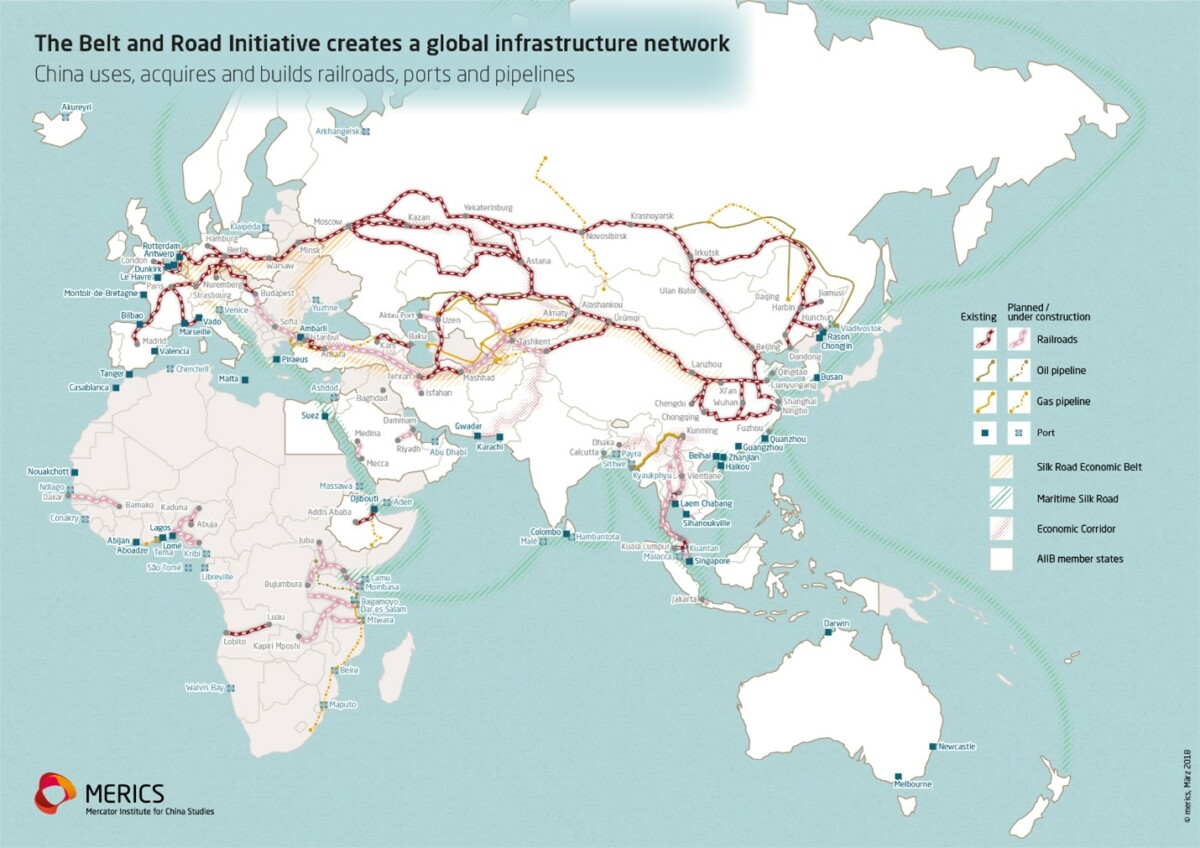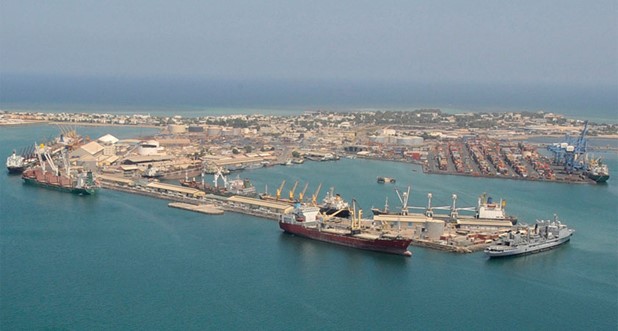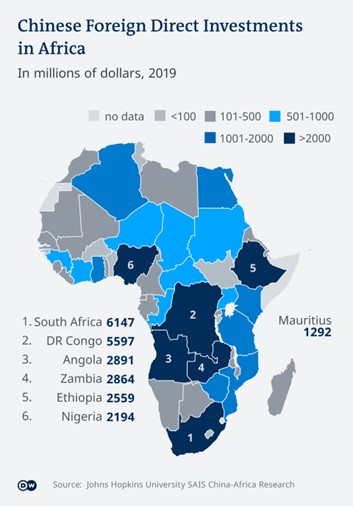The Belt and Road Initiative in Africa
PDF Version
1st Lt Brendan H.J. Donnelly, USAF | June 10th, 2023

In the international economic landscape,
the United States, China, India, Germany, and Japan are the five largest
economies in the world, making up about half of the world’s entire Gross
Domestic Product (GDP). Yet, China launched the One Belt One Road (OBOR)
initiative back in 2013 also known as the Belt and Road Initiative (BRI). This
massive project is meant to grow and link the Chinese influence and economic
resources with Europe, Asia, Oceanic countries, Africa, and South America. With
this expansion the Chinese military is also expanding along with the BRI to almost every continent on Earth.[1]
The completion of BRI would allow China to match and potentially outmatch the
economy and global military reach of the United States.
The expansion projects vary between
physical infrastructure, technology, and communications. One of the largest
projects so far has been the China-Pakistan Economic Corridor (CPEC), which
cost $62 billion and opens an economic corridor for China in the west other
than their port in the South China Sea (SCS) and East China Sea (ECS).[2]
Ultimately the goals of BRI have been stated as advancing the global economy,
and boosting the economies of BRI states and in the benefit of China giving the
Chinese government additional geo-political leverage over BRI states as well. For
the United States, the BRI initiative is a serious economic and military
concern that will challenge the economic ties and freedom of movement for the
U.S. military over the next few decades. Some analysts
assess that at the end of the BRI initiative China will have spent $8 trillion
dollars and begs the question, can the United States match this type of global
investment?[3]
Although the other piece of concern is in Africa. What this paper aims to
discuss is how the BRI initiative impacts Africa and what does this impact means
to the global outlook.
What is the Belt and Road Initiative?
First, the BRI has two components like the
name implies one road and a belt. The “Belt” is the Silk Road Economic Belt
that creates six land corridors that connects China with Central Asia and
Europe.[4]
The “Road” is the Maritime Silk Road that establishes sea ports that connect to
Africa and to South America.[5]
At this time, 65 countries have signed onto pieces of the overall BRI program,
which includes 1,700 infrastructure projects from 50 state-owned Chinese
companies.[6]
The key word here is that all of these projects to include pipelines, roads,
buildings, railroads, naval ports and more are run by the Chinese Communist
Party (CCP) owned businesses.
How this relates to Africa, is that
since these projects are sanctioned by the CCP and the
African nations government, these Chinese companies claim that they are
building up the infrastructure, but at the same time they are making these
African nations increasingly dependent on the Chinese economy and the CCP
itself. The billions of dollars that China is pushing into African nations such
as Djibouti and Kenya, for example, in fact do support their infrastructure,
but since these African nations cannot pay back the investment have no other
choice than allowing Chinese companies to stay and work in their nations.
Although China claims that these businesses will provide additional jobs for
African workers, it really creates jobs for Chinese workers in Africa.
The immediate result of Chinese
companies being in Africa lies in security. It is very well known that Africa
has a serious security issue with terrorism, crime, and political corruption.
For example, in Djibouti, their government is known for controlling social
media within the country, violently squashing protests and maintaining
political control in the government through shady means.[7]
Due to this corruption China states that there is a security risk and they must
protect their strategic national economic interests, so then China creates
infrastructure to support their military to have a consistent presence in these
East African nations. The prime example of this is Djibouti and Kenya since
China has developed military naval ports in both countries to support the
Peoples Liberation Army Navy (PLAN).

Djibouti has had a PLAN naval port in
its country since 2016. This naval port originally was built
to provide economic access to the Red Sea for the Chinese but has gradually
become more of a military interest than before. The PLAN uses this port to
protect their economic interests of the coast of East African in the Indian
Ocean but with this security brings opportunities for growth. The U.S. has its
own naval port within 15 km of the Chinese port, so this has direct impacts to
U.S. Navy operations and international relations between the United States and
Djibouti. Thus, speaking of advancements some of these
include allowing Chinese aircraft carriers to dock. The U.S. Africa Command
(AFRICOM) reports that the port in Djibouti has expanded past its original
capabilities and can now permit PLAN Type-075 amphibious warships and Type-002
aircraft carriers to dock within the Red Sea area of operation. [8]
This expansion for larger types of naval vessels allows the PLAN to power
project their navy, like the United States does, which impacts the U.S. freedom
of movement in the western side of the Indian Ocean.
Another case study for how the BRI interacts with African
nations is Kenya, and the flagship project in Kenya is the Standard Gauge
Railway (SGR). This railway connects the capital of Kenya, Nairobi, with the country’s
largest port city, Mombasa.[9]
It is also critical to note that China is building a naval base close to
Mombasa, much like the PLAN base in Djibouti.[10]
Which even though the SGR is designed to support the Kenyan economy, it would
serve a dual purpose of supporting Chinese navy activity in East Africa as
well. To be fair, SGR did create 30,000 new jobs and transported 5.4 million
people, and 1.3 million shipments across Kenya.[11]
But even though SGR came at a success at first, the cost was the biggest issue.
The Export-Import Bank of China funded 90% of the SGR project while 10% was
funded by the Kenyan government, but then after the project was completed China
called for the payment of the loan by the Kenyan government.[12]
The debt that Kenya owed to China quickly became 55.5% of their Gross Domestic
Product (GPD), and with the SGR jobs being low-paying jobs many workers did not
stay with the project, thus making it impossible for the Kenyan government to
sustain the railway. This is a prime example for how China used an African
nation that they considered “susceptible to possible debt default” so that they
can then economically control the nation they invested in, then use it to build
naval ports, infrastructure, military bases, and whatever China wants since
Kenya owes them so much money.[13]
Belt and Road Initiative Impacts
One of the positive impacts that BRI
brings to Africa is an influx of jobs, even though they will be jobs working
for Chinese companies. The number of available jobs is critical for Africa in
the upcoming years based on the projected population growth on the continent.
By 2050 the United Nations projects that the population of Earth is expected to increase to 9.7 billion, and Africa will make
up 1.3 billion of this (17%).[14]
Currently, Africa has the highest rate of population growth globally, with most
of this growth being youths. Each year about 10-12 million youths enter the
labor market in Africa while only 3 million jobs are created, and this
disparity has dire side-effects.[15]
With 7 million youths unable to find work their options are slim, being agricultural
work, joining a military, or joining a militant/terrorist group to name some of
the primary jobs for youths. BRI provides additional jobs that will keep youths
in Africa from joining a violent cause, thus increasing the overall threat in
Africa as well. Although these youths are not working for African businesses,
it is still a positive measure to bring jobs into Africa from Chinese companies
to build up the infrastructure in multiple nations.
This positive outlook on job creation is echoed through the media as well. From the State Council
Information Office of the Peoples Republic of China, they state that “China is
not here to exploit Africa as the western world perceives, because looking at
the African infrastructure development side, the BRI is helping Africa to
transform itself. China comes with the help Africans need”.[16]
Even though this is what the Chinese government publishes this may not be
correct since it is also known that many BRI companies produce jobs, and are
funded by the Chinese government, they usually come with a price tag that
allows these Chinese companies to remain in Africa indefinitely without
compensating the African nations government. This tactic does provide jobs and
support infrastructure development, like Frederick Golooba
Mutebi, a Ugandan researcher presents, but what is not
published by the Peoples Republic of China (PRC), is that they maintain
these businesses and use them to economically control and influence African
nations as well.
On the other side of the coin, one of
the most significant negative impacts that comes with BRI is the
over-dependence on the Chinese economy. If a country, like any of the African
nations that coordinate economically with China, become over dependent on
Chinese foreign trade, this opens each of them up to a critical economic
weakness. This weakness is their own economy is susceptible to global economic
impacts, or more specifically, any “speed bumps” that negatively impact the
Chinese economy.[17] With
the global economy becoming more interconnected with China and the United
States at the forefront of this, any negative impacts to either country can
also then impact any African nation that relies on either country as well.
What needs to happen instead of this
dependency on foreign governments and economies to build up the African nations
is investment into industry and a strong security posture. For example, instead
of Chinese or American countries building infrastructure and businesses of
their own in Africa, investors should support indigenous African companies that
can thrive with the international support. One of these companies is Jumia, an
e-commerce company based out of Nigeria.[18]
Jumia supports the internet connection of other large and small companies in 10
nations to include, Nigeria, Ghana, Uganda, Tunisia, Senegal, Morocco, Kenya,
Egypt, Algeria, and the Ivory Coast.[19]
Investing in businesses like Jumia where they are African-based, African-run
companies, will grow each nation’s economy and will keep these nations from
being susceptible to global economic trends. The BRI does not support this
idea, instead it pushes more dependence on the Chinese economy.
Impacts to the Indo-Pacific Region
The BRI program is an economically
aggressive policy that the United States and the Indo-Pacific leaders need to
be worried about. Ultimately, BRI has many examples of
Chinese economic influence in East Africa which is the first domino to fall,
which will eventually lead to military presence in the area as well. Two of the
most important naval economic corridors are in the Indo-Pacific, the Red Sea
off Djibouti, and the South China Sea. Presently, the PLAN is a brown water navy,
which means that they mainly operate in their
territorial waters and off their coast, but with the assistance of BRI more
naval ports in East Africa provide an extended military reach for the PLAN.
This also supports the eventual goal of the PLAN to be a blue water navy,
meaning that they can globally operate in any international waters and present
themselves across all oceans. These developments with the PLAN alongside the
economic control that China obtains through BRI when African nations default on
debt is a critical action that goes against the United States strategic goals
in the area.
Additionally, since the United States
is greatly invested in East Africa, economically
combatting the Chinese influence in the area is key. Some of
the U.S. goals in East Africa are counterterrorism, supporting good governance,
and ensuring economic freedom in the Indo-Pacific. Without diplomatic,
economic, and military action enacted by the United States, then BRI and the
Chinese government will de facto control the economy in East Africa and the
international waters in the areas as well, thus threatening the security of
U.S., Indian and Indo-Pacific partners trade that flows through the area.
Therefore, a suggestion for the U.S. economically, would be to support indigenous
East African businesses that can grow without most of
the investment from the U.S., unlike the situation in Kenya. If the U.S. and
our partners can economically support East African companies and allow them to grow
on their own, job creation can be sustained, and the nation’s economy will boom
instead of drop due to debt concerns. In terms of
diplomatic suggestions, the U.S. and other Indo-Pacific partners should
increase diplomatic ties, economic alliances, and diplomatic alliances to
ensure East African security from terrorist groups, and violent extremist
actors. Finally, the U.S. military should continue their counter-terrorism
mission in East Africa, while increasing their naval presences off the coast of
East Africa to ensure the safety of all Indo-Pacific and African partners trade
assets.
With the execution of these
suggestions, and the support of informing the public, businesses, and partners
through the media, it is likely that East African nations, and Indo-Pacific
partners can counter BRI. As mentioned, BRI is one of the most ambitious economic,
diplomatic, and military plans that China has undertaken, and because of this,
countering this action by the United States is critical in
order to stay relevant in East Africa. Without intervention, the PRC
will continue to force East African countries to default and permit Chinese
companies to use African resources, port access, and their population. All of
this then increasing the geo-strategic resources available to China and allow
the PLAN to grow towards their goal of matching the capabilities of the U.S.
Navy within the next few decades.
Author Biographies:
1st Lt Brendan H.J. Donnelly, USAF
Lieutenant Donnelly is
an intelligence officer stationed at Cannon AFB, NM. He has held intelligence
supervisor roles at Cannon AFB and Special Operations Forces Africa. He
graduated Bowling Green State University, with a Bachelor of Arts of Sciences,
majoring in History.
References
[1]James McBride, Noah Berman, Andrew Chatzky, “China’s Massive Belt and Road Initiative” Council on Foreign Relations, (February 2, 2023), https://www.cfr.org/backgrounder/chinas-massive-belt-and-road-initiative.
[2] Ibid.
[3] Ibid.
[4]
Paul Nantulya, “Implications for Africa
from China’s One Belt One Road Strategy”, Africa Center for Strategic
Studies, (March 22, 2019) https://africacenter.org/spotlight/implications-for-africa-china-one-belt-one-road-strategy/.
[5] Ibid.
[6] Ibid.
[7] Siegle, Joseph; Cook, Candace, “Taking Stock of Africa’s 2021 Elections” Africa Center for Strategic Studies (January 12, 2021) https://africacenter.org/spotlight/2021-elections/.
[8] Sam LaGrone, “AFRICOM: Chinese Naval Base in Africa set to Support Aircraft Carriers”, United States Naval Institute News, (April 20, 2021) https://news.usni.org/2021/04/20/africom-chinese-naval-base-in-africa-set-to-support-aircraft-carriers.
[9] Phebe Wilson-Andoh, “China’s Belt and Road Initiative in Kenya”, Foreign Policy Research Institute, (May 18, 2022), https://www.fpri.org/article/2022/05/chinas-belt-and-road-initiative-in-kenya/.
[10] Eric Miller, “More Chinese Military Bases in Africa: A Question of When, Not If”, Foreign Policy, (August 16, 2022) https://foreignpolicy.com/2022/08/16/china-military-bases-africa-navy-pla-geopolitics-strategy/.
[11] Ibid.
[12] Ibid.
[13] Ibid.
[14] United Nations, “Peace, Dignity and Equality on a Healthy Planet” United Nations, (2020) https://www.un.org/en/global-issues/population.
[15] Goldstone, Jack A. “Africa 2050: Demographic Truth and Consequences” Hoover Institution (January 14, 2019), https://www.hoover.org/research/africa-2050-demographic-truth-and-consequences.
[16]
Xinhua, “Belt and Road Initiative transforming Africa’s development landscape:
Experts”, State Council Information Office of the Peoples Republic of China,
(August
25, 2022), http://english.scio.gov.cn/m/beltandroad/2022-08/25/content_78388818.htm#:~:text=%22China’s%20Belt%20Initiative%20has%20provided,trading%20opportunities%2C.
[17] C.K.S. Chun "Chapter 15: Economics: A Key Element of National Power" US Army War College Guide to National Security Issues, 4th edition: Volume I. (2010).
[19] Ibid.